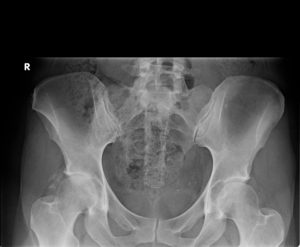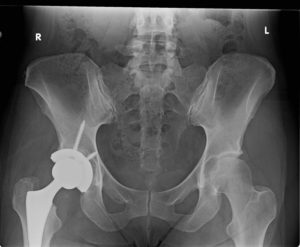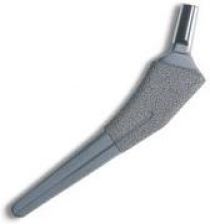Symptoms of Hip Arthritis
Arthritis of the hip can be a debilitating condition that leads to pain, immobility and a decreased quality of life. Common symptoms include groin pain, hip stiffness and gait abnormalities. When non-operative treatment fails, total hip arthroplasty (replacement) is an excellent option.

51-year-old female golfer with severe osteoarthritis of the right hip and intractable pain of the groin and lateral hip
Total Hip Arthroplasty for Treating Hip Arthritis
Total hip arthroplasty is one of the most successful procedures in all of medicine. When done correctly, results are generally excellent.
Hip replacement involves removal of the arthritic surfaces of the femoral head (the “ball”) and the acetabulum (the “socket”). The acetabulum is resurfaced with a prosthetic cup and a modular liner. The femoral head is replaced with a femoral stem and prosthetic ball.
Choosing a Material for the Prosthetic Bearing Surfaces
The prosthetic bearing surfaces of the headball and cup can be made from one of several materials including cobalt chromium (metal), ceramic, and polyethylene (plastic). Each of these bearing options carries different risks and benefits. The type of bearing surface utilized depends on several factors including patient age, activity demands, and surgeon experience. A patient is encouraged to discuss these options with his/her surgeon when considering total hip replacement.
Minimally-Invasive Total Hip Replacement Options
Hip replacement can be done through one of several different approaches. Traditionally, a large anterior, posterior, or lateral approach was performed to gain exposure to the hip. Although effective, this led to increased blood loss, significant muscle trauma and slower recovery times.
Recently, minimally-invasive surgical techniques have offered several improvements over traditional approaches. Although more technically demanding, minimally invasive surgery allows for less muscular trauma and quicker patient recovery. This can be especially helpful in younger and more active patients.

After undergoing successful right total hip replacement, patient was able to return to golf 3 weeks after surgery with minimal pain
Dr. Wind’s Experience with Total Hip Replacements

Dr. Wind has extensive practice and fellowship experience in total hip replacement. He performs approximately 400 total hip replacements each year which is far more than any other surgeon in central Virginia. Furthermore, he benefited greatly from specialized fellowship training in hip replacement at the Southern Joint Replacement Institute in Nashville, TN. He has experience with several different hip implant systems and all available bearing surface options.
Dr. Wind performs hip replacement through a minimally invasive anterior approach to the hip. This approach allows exposure of the hip without cutting any of the muscles in the process. The usual incision is approximately four inches in length. Every attempt is made to mobilize the patient with physical therapy immediately after surgery. The average length of stay after surgery is 12-24 hours. Many patients are now discharged home on the same day of surgery after passing physical therapy. Criteria that patients must meet for early discharge include adequate pain control, ability to tolerate food/liquids, ambulate independently using a walker, and ability to climb/descend stairs.
